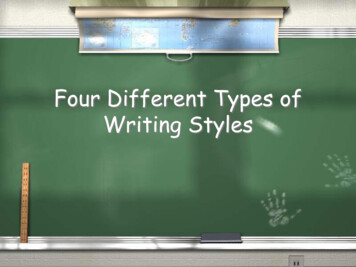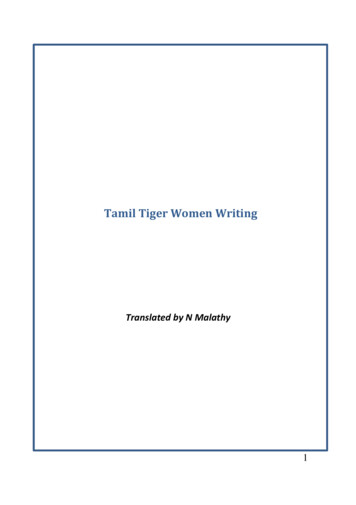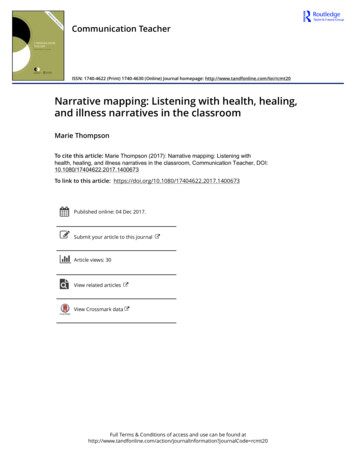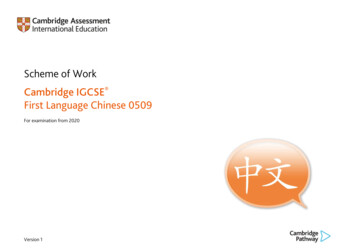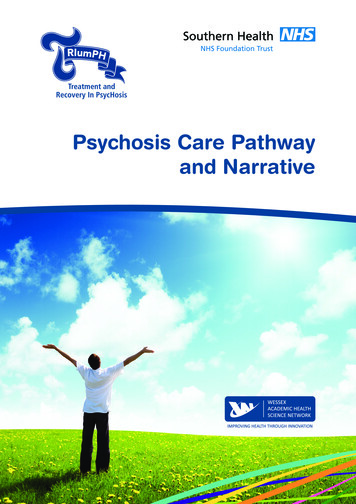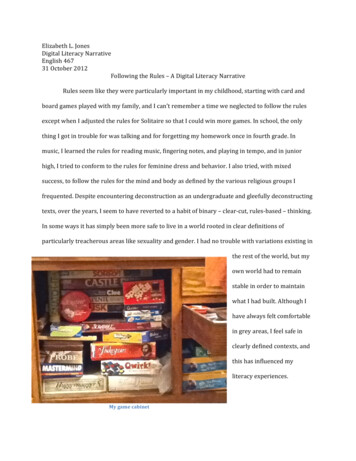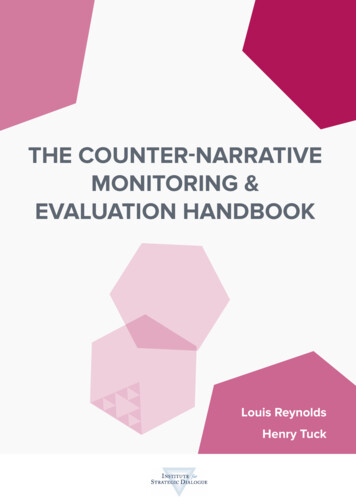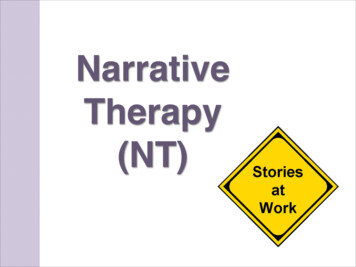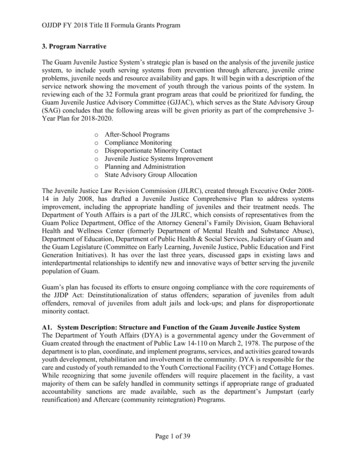
Transcription
OJJDP FY 2018 Title II Formula Grants Program3. Program NarrativeThe Guam Juvenile Justice System’s strategic plan is based on the analysis of the juvenile justicesystem, to include youth serving systems from prevention through aftercare, juvenile crimeproblems, juvenile needs and resource availability and gaps. It will begin with a description of theservice network showing the movement of youth through the various points of the system. Inreviewing each of the 32 Formula grant program areas that could be prioritized for funding, theGuam Juvenile Justice Advisory Committee (GJJAC), which serves as the State Advisory Group(SAG) concludes that the following areas will be given priority as part of the comprehensive 3Year Plan for 2018-2020.ooooooAfter-School ProgramsCompliance MonitoringDisproportionate Minority ContactJuvenile Justice Systems ImprovementPlanning and AdministrationState Advisory Group AllocationThe Juvenile Justice Law Revision Commission (JJLRC), created through Executive Order 200814 in July 2008, has drafted a Juvenile Justice Comprehensive Plan to address systemsimprovement, including the appropriate handling of juveniles and their treatment needs. TheDepartment of Youth Affairs is a part of the JJLRC, which consists of representatives from theGuam Police Department, Office of the Attorney General’s Family Division, Guam BehavioralHealth and Wellness Center (formerly Department of Mental Health and Substance Abuse),Department of Education, Department of Public Health & Social Services, Judiciary of Guam andthe Guam Legislature (Committee on Early Learning, Juvenile Justice, Public Education and FirstGeneration Initiatives). It has over the last three years, discussed gaps in existing laws andinterdepartmental relationships to identify new and innovative ways of better serving the juvenilepopulation of Guam.Guam’s plan has focused its efforts to ensure ongoing compliance with the core requirements ofthe JJDP Act: Deinstitutionalization of status offenders; separation of juveniles from adultoffenders, removal of juveniles from adult jails and lock-ups; and plans for disproportionateminority contact.A1. System Description: Structure and Function of the Guam Juvenile Justice SystemThe Department of Youth Affairs (DYA) is a governmental agency under the Government ofGuam created through the enactment of Public Law 14-110 on March 2, 1978. The purpose of thedepartment is to plan, coordinate, and implement programs, services, and activities geared towardsyouth development, rehabilitation and involvement in the community. DYA is responsible for thecare and custody of youth remanded to the Youth Correctional Facility (YCF) and Cottage Homes.While recognizing that some juvenile offenders will require placement in the facility, a vastmajority of them can be safely handled in community settings if appropriate range of graduatedaccountability sanctions are made available, such as the department’s Jumpstart (earlyreunification) and Aftercare (community reintegration) Programs.Page 1 of 39
OJJDP FY 2018 Title II Formula Grants ProgramOne of the responsibilities of the department is to have general purview of youth activities withinGuam. The department’s mission is to improve the quality of life on Guam by the developmentand implementation of programs and services that promote youth development, strengthen thefamily units and communities of these juvenile offenders, and to ensure the offenders are providedwith appropriate treatment and are held accountable of their actions.The system has a range of methods and programs for addressing juvenile crime, taking into accountthe severity of the offense and the background of the youth offender. Establishing a comprehensiveapproach to providing services and programs to youth involves coordination and collaborationwithin the Guam Juvenile Justice System. The system provides for escalating responses to offenseson increasing severity such as probation and incarceration. Because the system has a goal forrehabilitation, many more agencies within the Government of Guam, to include the GuamDepartment of Education, Guam Behavioral Health and Wellness Center, Department of PublicHealth and Social Services, Guam Police Department, village Mayors and other community-basedorganizations are key players in providing services addressing juvenile tion andadjudication of juvenileoffenders, status offendersand non offendersFunctionPre-disposition anddisposition of juvenileoffenders, status offendersand non offendersSanctuary, IncorporatedNon-profit organization foryouth, runaways, victims of abuseTemporary shelter, parentingcase management, counseling,drug and alcohol treatmentLaw EnforcementGuam Police Dept.Juvenile investigation andprocessingRelease or referral toappropriate service providersCourtsPre-adjudication andadjudication of juvenilecases and certified youthas adultsPre-disposition anddisposition of juvenilecases and certified youthas adultsYouth CorrectionalFacility (DYA)Care and custody ofjuvenile offendersTreatment, case management,counseling servicesCottage Homes(DYA)Custodial care for statusoffendersTreatment, case management,counseling servicesYouth Resource Centers(DYA)Youth development, prevention,intervention, treatment andrehabilitation and aftercareSkills-development,after-school activities,mentoring, outreach,case management, crisisintervention, counselingPage 2 of 39
OJJDP FY 2018 Title II Formula Grants ProgramThe following system flow chart provides an overview of the movement of juvenile offenders,status offenders and non offenders entering and exiting the system.Guam Juvenile Justice Flow Chart(1996 to present)GPDJuvenileJPODOEFurther Confinement by maintainingcontinuing jurisdiction from age 18 to 21Department of YouthAffairs Pre- Adjudicationor AdjudicationCPSOut ofSystemFamily CourtRelease to Parents or Court preventionprograms/ ServicesCOMPREHENSIVE STRATEGYPreventionGraduated SanctionsSECURED FACILITYJUMPSTARTYCFFamily Re-Unification Process& Family StrengtheningNON CONFINEMENTCottage HomesAFTERCARECommunity RentegrationProcessAge 16 or older, automaticcertification as an adult,confinement to DOC for 1stand 2nd degree felonyCounsel and ReleaseRELEASEFurther provide services andactivitiesPage 3 of 39
OJJDP FY 2018 Title II Formula Grants ProgramAccountability-based sanctions within DYA’s continuum of services are illustrated in the followingchart.DYA: System of Graduated SanctionsOutreach, Prevention, Diversion,InterventionTreatment & Rehabilitation, EarlyReunification, Community ReintegrationCONTINUUM OF SERVICESCSDU/RCsPrograms forchildren/youth/familiesYouth CorrectionalFacility &Cottage HomesTreatment Community Reintegration-----------------------Graduated Sanctions------------------Programs for Children/Youth/Families24-hour crisis interventionAfter-school ActivitiesAlternatives to SuspensionCase Management (court advocacy, etc.)Case Reviews (treatment/behavioral plans)Chansa (youth/parent workshops)Clinical Psychological and CounselingComputer LabsCommunity ServiceIntake, risk/needs assessmentsJob training (DOL, DPHSS)Outreach counseling/psychological servicesSCORE (school outreach presentation)School shadowingSports and RecreationSupport counseling/groupsTutoring/MentoringPrograms for non-status (criminal), statusand non-offenders (abuse/neglect), certifiedyouths24-hour crisis interventionAftercare (community reintegration)Case Management (court advocacy, etc.)Case Reviews (treatment/behavioral plans)Clinical Psychological and CounselingGCC Basic Computer ProgramIntake, risk/needs assessmentsJumpstart Program (early reunification)Liheng Famagu’on DOE SchoolQuality time, Weekend & Extended FurloughSpiritual OrganizationsSupport groupsStep Plan ProgramTutoring/mentoringUOG 4-H workshopsLegend: CSDU/RCs Community Social Development Unit/Resource CentersDOE Department of EducationDOL Department of LaborDPHSS Department of Public Health and Social ServicesGCC Guam Community CollegeSCORE School Children OutReach Empowerment ProgramUOG University of GuamYoutPage 4 of 39
OJJDP FY 2018 Title II Formula Grants ProgramAnalysis of juvenile delinquency and problems (youth crimes) and needs.The island’s juvenile justice system is comprised of the police, juvenile courts, Attorney General’sFamily Division, Youth Correctional Facility (YCF) and Cottage Homes. Key areas of concernpreviously identified by the GJJAC/SAG relative to the analysis of juvenile crime trends and gapsthat exist within the juvenile justice system include the following: the overuse of court orders toviolate youth in the juvenile justice system; difficulty of determining appropriate treatment foryouth, especially those suffering from mental disorders; growing issues with migration from otherislands; and limited funds for alternatives for youth. As agencies undergo changes and priorities,the GJJAC/SAG acknowledged that collecting data has also been difficult to obtain. Limitedstatistics have shown juvenile crime trends between periods. While data collection capacityremains challenging for Guam, the juvenile justice system continues to strengthen its collaborativetracking system for juvenile offenders from the point of entry to release into the community.Inclusive of the 3-year planning process, as recognized by the Department of Youth Affairs(DYA), is the need for specific gender-related services for its juvenile clientele. DYA’s cliniciansare trained to recognize when a referral is needed for gender-specific services. If a request is madeby the youth and/or the clinician/social worker believes that a female teenager needs a femaletherapist or female only program, they are immediately referred (e.g. Big Brothers Big Sisters,Island Girl Power, Girl Scouts). In the community, the court provides therapy services withnumerous licensed therapists at the Client Services and Family Counseling Division. For alcoholand drug addicted young adult females who are incarcerated, there is an Oasis Program offered bythe Salvation Army that was developed specifically for females. The social workers and cliniciansemployed at DYA who work directly with juveniles within and outside of the facility have workedclosely with staff to address any gender issues that may be salient for the youth.DYA and the Guam Behavioral Health and Wellness Center (GBHWC) have been working veryclosely and successfully in providing appropriate assessment and treatment services forincarcerated juveniles and those placed in aftercare (transitional) services. This came as a result ofdirect meetings with the GBHWC administration and clinical service heads for children andadolescents. Before these meetings, there were challenges with referring youth, including followup by the GBHWC staff. At the current time, DYA is very satisfied with the services provided byGBHWC as youth referred have been seen and assessed 100% of the time and most importantly,they have worked closely with DYA staff to make follow-up clinical/medication appointments forthe youth. The DYA clinical staff (licensed clinical psychologist and licensed therapist) helpfacilitate the services between the two agencies. They have been instrumental in thecommunication and the subsequent improvements that needed to happen in the referral processes.Information sharing among youth service providers is improving. However, DYA continues toestablish contact and as a result, the data provided in the subsequent pages were obtained frommajor sources involved with youth going through the system. The data shown would be the basisof the juvenile crime analysis, reflecting increases and decreases in juvenile offending.The Guam Police Department’s Juvenile Investigation Section (JIS) is responsible for theenforcement of juvenile laws and the prevention, intervention and/or investigation of crimesPage 5 of 39
OJJDP FY 2018 Title II Formula Grants Programcommitted by alleged juvenile perpetrators. JIS makes the initial contact with juveniles within thejuvenile justice system.Table 1 Juvenile Offenders by Offense 2015 – 2017 illustrates data for 2017 with offensescommitted at 221 crimes with an overall increase in major crimes such as burglary, stolen propertyand disorderly conduct. Larceny theft, simple assaults, liquor laws and drunkenness consistentlyheld the highest offenses from 2015 to 2017, while highest increases in 2017 were seen in burglaryand liquor laws. There were no murders reported. Status offenses (runaways and beyond control)and curfew violations rose by 76% in 2017. Overall, total offense rate increased by 32% in 2017.Table 1. Juvenile Offenders by Offense 2015 - 2017OffenseMurderRape/Criminal Sexual ConductRobberyAggravated AssaultBurglaryLarceny – TheftVehicle TheftArsonAssaults, simpleForgery and CounterfeitsFraud and Bad ChecksStolen PropertyVandalismWeapon ViolationsSex OffensesDrug Abuse ViolationsOffenses Against Family and ChildrenDriving Under the InfluenceLiquor LawsDrunkennessDisorderly ConductAll other OffensesCurfew ViolationsRunaways/Beyond ControlTOTAL JUVENILE OFFENDERSSource: Guam Police 19115125Table 2 DYA Admissions 2015 – 2017 shows total admission had decreased 24% from 474 in2016 to 361 in 2017. The decline in admissions is attributed to various agencies’ collaborativeefforts to partake in the 2016 Juvenile Justice Comprehensive Community Supervision Task Force,coordinated by the Judiciary of Guam to address juvenile justice programs and services, reviewcurrent juvenile policies supported with research and seek strategies to strengthen familyengagement involving evidence and community-based programs to reduce recidivism.Page 6 of 39
OJJDP FY 2018 Title II Formula Grants ProgramTable 2. DYA Admissions 2015 – 2017Year201520162017Total Admission3994743611st contact1521871282nd or more contacts247287233DYA’s recidivism rate in Table 3 shows there were more justice-involved youth referred and inneed of services during 2017. Efforts to address recidivism continues, to include the formula ofdata tracking relative to Violations of Court Orders (VCOs) being counted as a contact.Table 3. DYA Recidivism Rate 2015 - 201720152016201761.90%60.54%64.54%DYA’s strategies are to continue its efforts to aid in reducing the recidivism rates. Its cliniciansand social workers utilize quasi-MST (Multisystemic Therapy) as its primary model for treatment.Research has shown that MST, an evidence-based approach, reduces youth delinquent criminalbehaviors. MST focuses on the factors of each youth's social network that are contributing to hisor her antisocial behavior. The primary goals of MST programs are to decrease rates of antisocialbehavior and other clinical problems, improve functioning (i.e. family relations, schoolperformance) and achieve these outcomes at a cost savings by reducing the use of out-of-homeplacements such as incarceration, residential treatment, and hospitalization. The ultimate goal ofMST is to empower families to build a healthier environment through the mobilization of existingchild, family, and community resources hence, reduction of reoffending.DYA and the court continue to unify rehabilitative treatment services, such as risk and needsassessment tools to determine the classification of juveniles as low-medium or high risk andestablish programs tailored to their individual needs. Additional assessments prior to releasestrengthen re-entry, follow up and supervision services.Table 4 DYA Top Five Offenses 2015 - 2017 shows consistent high numbers of VCOs, whichmade up 49% of juveniles admitted in 2017 for this offense. The second highest offense, beyondcontrol has shown an increase compared to the previous year and made up about 29% ofadmissions.Page 7 of 39
OJJDP FY 2018 Title II Formula Grants ProgramTable 4. DYA Top Five Offenses 2015 - 201720152016Violation of Court Order Violation of Court ult(27)(35)Beyond ControlTruancy(16)(31)Criminal Sexual ConductBeyond Control(16)(29)2017Violation of Court Order(178)Beyond 4)Burglary(15)Chronic juvenile offenders with two or more contacts continue to receive the treatment they needwhile confined in the Youth Correctional Facility (YCF) or Cottage Homes with consideration forplacement in the early reunification or reintegration into the community through extendedfurloughs or the Jumpstart Program. These programs require frequent visitations and spot checksby DYA staff to gauge compliance as well as exit interviews with the youth and parents/guardiansto rate personnel performance, programs and services, and address issues/concerns.The Jumpstart Program gives the juvenile the opportunity to be on extended furlough while stillunder the custody of YCF or Cottage Homes. The concept of the program is to give the juvenilehis or her role and responsibilities in the home and community. This will allow the strengtheningof the family units while support from clinical, professional and technical staff continues for eachjuvenile. The juvenile is guided for eventual release from YCF. Upon release, they may be referredto Aftercare, a community reintegration program. Accordingly, the next step to assisting juvenilesand their families during the reintegration phase is through the Aftercare component.Within the community, DYA established Youth Resource Centers in the northern (Dededo),central (Mangilao) and southern (Agat) regions of Guam to offer programs and services forchildren, youth, and families, including those with special needs and disabilities and youth in thejuvenile justice system. In efforts to support court-involved youth released from DYA, theAftercare Program was established to help prevent them from returning to the YCF or CottageHomes.Table 5 DYA Aftercare Program 2015 – 2017 shows the number of clients served. In 2016, 86%of 70 clients receiving Aftercare services did not return to the YCF and Cottage Homes while in2017, 17% of 78 clients returned to the facilities.Table 5. DYA Aftercare Program 2015 - 2017ProgramAftercare201598Page 8 of 39201670201778
OJJDP FY 2018 Title II Formula Grants ProgramThe Aftercare Program team consists of social workers/center supervisors, youth service workers,community program aides, and clinicians. The team also utilizes a quasi-multi-systemic therapyapproach. Two critical services of the Aftercare Program are intensive monitoring and counseling.Intense monitoring occurs in the home and school settings. The youth service workers, assisted bycommunity program aides conduct daily school monitoring, spot checks, confer with teachers andschool administrators, and retrieve attendance and other reports, such as academic performance,behavioral concerns or issues. These consultations provide further insight to the respective socialworker by being proactive and more responsive to the unique needs of each client and guidehim/her to become academically successful.Counseling services are accessible for clients under the Aftercare Program. Clinicians utilize theCognitive Behavioral Therapy (CBT) as the primary model of treatment. CBT aims to affectnegative behaviors into positive behaviors by changing the way a person thinks, as well asregulating emotions. Social workers and clinicians work hand in hand with the clients and theirfamilies to identify determinants of anti-social behaviors, develop treatment plans and establishgoals targeting behavioral changes, reinforce treatment plans and assist in goal achievement andnavigate community resources. Therefore, the quality of services rendered support positive youthdevelopment that ultimately aims to prevent the client from re-offending and re-entering YCF andCottage Homes.The Family Court can defer cases to this program as an alternative to incarceration. Thiscomponent will allow levels of monitoring and other services for a minimum of six months up to12 months. Additional phases of Aftercare allow families to continue services as needed.Recent and ongoing literature and statistics have shown that upon a juvenile’s release from acorrectional facility setting, if no follow-up care is provided, the likelihood is that the particularjuvenile will either violate again or commit another offense, which may continue into theiradulthood. The recidivism rate is much higher in juveniles where no follow-up care and/or servicesare provided versus the ones who do receive such services. Often times, troubled youth have pooracademic standings because they lack self-esteem and consequently, this usually contributes tonegative anti-social behavior. DYA firmly believes that if youth are empowered with knowledgeand education, then their overall sense of value and self-worth will increase, which will ultimatelyassist in improving their overall behavior within the classroom and school settings, homes, andwithin their community.Individualized and family centered programs along with community-based programs as BigBrothers Big Sisters and Island Girl Power help to reconnect youth to their respectiveneighborhoods. More services require additional staff and consistent funding; thereforecoordinated volunteer efforts from the general population (i.e. military, senior citizens, youthgroups) should always be pursued. DYA also welcomes community volunteers.The demographic makeup of juveniles served in DYA consists of male minors from single unwedparents and socioeconomic impoverished homes, both impacting their educational attainment andlikelihood of statistical success in Guam’s society. Male minors continue to make up the majorityof the DYA population.Page 9 of 39
OJJDP FY 2018 Title II Formula Grants ProgramTable 6 DYA Admissions Top Five Age Groups 2015 – 2017 reflects the age of 16 as highestranked overall.Table 6. DYA Admissions Top Five Age Groups 2015 - 201720152016201713 y.o.30484614 y.o.54684115 y.o.90965116 y.o.1091046617 y.o.738465Table 7 illustrates Superior Court Juvenile Case Filings from 2015 to 2017. Recently, the Judiciaryof Guam announced its action plan for Juvenile Justice Reform with critical focus areas andacknowledging that Chamorros and Chuukese are the highest court involved youth whileChuukese are over-represented.Table 7. Superior Court Juvenile Case Filings 2015 – 2017Classification20152016Juvenile Delinquent193208Juvenile Drug Court233200Juvenile Proceeding609504Total1035912*Juvenile Drug Court filed as Juvenile Delinquency Cases.20172860*395681Juvenile Drug court cases which involve a drug or alcohol offense are now filed as JuvenileDelinquency cases. Juvenile Proceedings cases include juvenile guardianship matters, truancy,status offenses, and juvenile abuse and neglect cases.The courts will continue to target risk factors and match treatment with client needs and treatmentapproaches, including services that are research-based. Four focus areas are: evidence-basedpractices, juvenile court referral process (to reduce unnecessary referrals to juvenile court),juvenile defense and prosecution, including training of attorneys working with juvenile casematters, and court language (use developmentally appropriate language in court proceedings).Table 8 DYA Admissions Top Five Ethnic Groups 2015 – 2017 shows Chamorro and FSMjuveniles, particularly Chuukese, have been severely overrepresented in the juvenile justice systemand in DYA’s facilities. In 2017, Chuukese made up the largest single ethnic group at 59%followed by Chamorros at 31% of 361 admissions in DYA. Filipino and Palauan populations haveremained low in admission numbers and extremely under represented.Page 10 of 39
OJJDP FY 2018 Title II Formula Grants ProgramTable 8. DYA Admissions Top Five Ethnic Groups 2015 - 9Filipino9Other FSM9Other FSM9Other FSM9Other8Other15Other15The island community continues to have over-representation of FSM nationals. Root causes ofpoverty, system bias, less emphasis on education, and poor community integration have been verychallenging to overcome. Programs will continue to help focus and provide support and specialadvocacy via community partners and individuals to help deliver services to FSM youth and theirfamilies.Although the local and FSM youth continue to make up the largest segment, DYA recognizes adisparity with juveniles of Filipino descent, as these youth account for a small percentage of thetotal juveniles being admitted. DYA will work diligently to address the Chuukese population inthis program year and provide additional resource for the community in this language.Other contributing factors for the youth crime trends include poor parent/child relationship,gang/peer group influences, lack of positive role models, school academic failures and lack ofviable positive programs and activities in the community. Education is provided as mandated bypublic law for those who choose to stay in school or those who still exhibit appropriate behaviorswithin the school environment.With the exception of schools, there are limited outlets and island-wide activities for youth toattend and/or positively socialize. Outlets that are available usually require fees. For single-parenthomes and struggling families who are unable to afford the fees, an extra-curricular activitybecomes a hardship. Many of these youth come from schools and villages located in the northerndistrict of Guam, such as Dededo and Yigo, along with other more centrally located villages(Mangilao and Barrigada), where most of the admissions into DYA have come from.The GJJAC/SAG is aware of the heightened existence of drugs, alcohol, tobacco and violence inthe schools. It is important to identify the extent of each issue and seek alternatives to address theissues in hopes of reducing the occurrence of these issues in the schools and delinquencyassociated with use.Table 9 DYA Admissions Top Five Drug Use 2015 – 2017 illustrates the majority of juvenilesassessed during intake have reported alcohol-related offenses. Table 9 shows a decline of drug usereported by clients however, alcohol offenses remain prevalent as data from GPD shows violationsconsistently rating high in offenses charged.Page 11 of 39
OJJDP FY 2018 Title II Formula Grants ProgramTable 9. DYA Admissions Top Five Drug Use 2015 - a3835Ice42Tobacco00Other0020175929321Guam’s legal age to purchase and consume alcohol beverage is 21, a law that increased thedrinking age in July 2010. GPD reported that most juvenile cases involving criminal behaviorswere associated with alcohol. Guam recently passed a law to increase the legal tobaccoconsumption age to 21 and will be implemented in the year 2018.Drug use in schools has shown that marijuana continues to be the drug choice amongst the youthwith inhalants ranking second. GPD reported that the number of apprehensions have increasedsignificantly and relatively remained within the same range over the years.Within the Guam Department of Education (DOE), the school system continues to experienceyouth violence incidences on campus, however in Table 10 DYA Admissions by Schools showsGeorge Washington High School has dropped to fifth after being previously on top and that TiyanHigh School is the second highest for 2017. The establishment of this new high school for studentsfrom the central villages has alleviated overcrowding at GWHS. Through collaborative effortsbetween agencies and organizations, more outreach plans needs to be made as DOE will beredistricting student attendance this upcoming school year.Table 10. DYA Admissions by Schools: Top Five Schools 2014 - 2016Admissions: Top Five Schools201520162017George Washington HSTHSSHS616851Tiyan HSSimon Sanchez HSTHS485845Southern HSSHSSSHS455441John F. Kennedy HSF.B. Leon Guerrero MSJose Rios MS444733Okkodo HSGWHSGWHS393926The GJJAC/SAG stated it is necessary to continue the review of the most current Guam YouthRisk Behavior Survey for guidance in establishing more after-school programs that will allow atrisk youth the opportunities to be productive members of society.This review is part of the grant project activities as further elaborated under goals and objectives.In addressing clients’ school issues, DYA continues to work in partnership with DOE and others.DYA ongoing meetings with their administrators, offers its Alternatives to Suspension andPage 12 of 39
OJJDP FY 2018 Title II Formula Grants ProgramExpulsion Programs via the Resource Centers, outreach presentations about the realities ofinstitutional living, follow up Aftercare services upon clients return to their home schools, etc.Tables 11 and 12 Guam DOE Truancy Data for School Years 2015 and 2016 show the number oftruancies at all levels with a decline in 2016.ElementaryMiddle SchoolHigh SchoolTotalTable 11. Guam DOE Truancy Data School Year lementaryMiddle SchoolHigh SchoolTotalTable 12. Guam DOE Truancy Data School Year th regard to the issues relating to juvenile delinquency encompasses many areas, of highconcern is the island’s drug-related crimes and drugs entering Guam. The effect on youth criminalactivities has heightened public concern with regards to prevention and control. The Departmentof Youth Affairs, its partners and the GJJAC/SAG recognize there is no one method or programof prevention that will control or curb the problems of juvenile delinquency. The prevention andcontrol of the total juvenile delinquency problem will require several means and new alternativesmethods in delinquency prevention and rehabilitation for juvenile offenders. Collaborative efforts,data collection, including training o
OJJDP FY 2018 Title II Formula Grants Program . Page 1 of 39 . 3. Program Narrative . The Guam Juvenile Justice System's strategic plan is based on the analysis of the juvenile justice system, to include youth serving systems from prevention through aftercare, juvenile crime problems, juvenile needs and resource availability and gaps.
